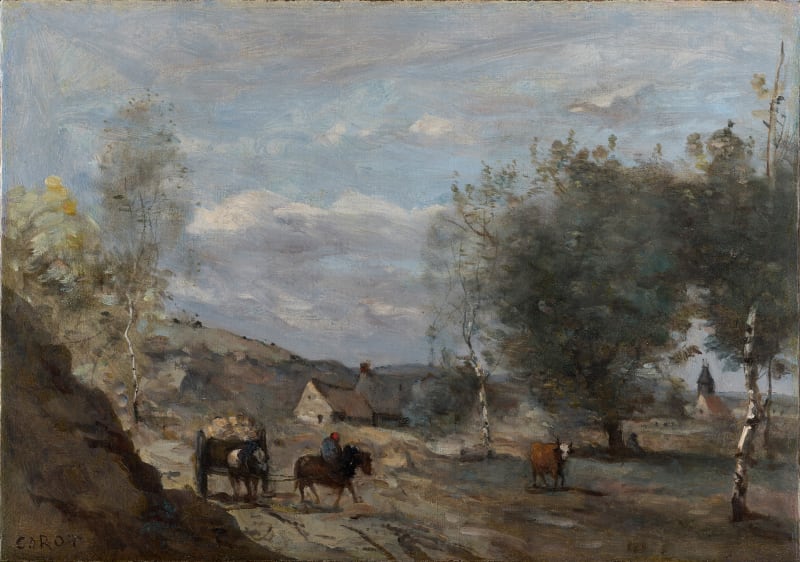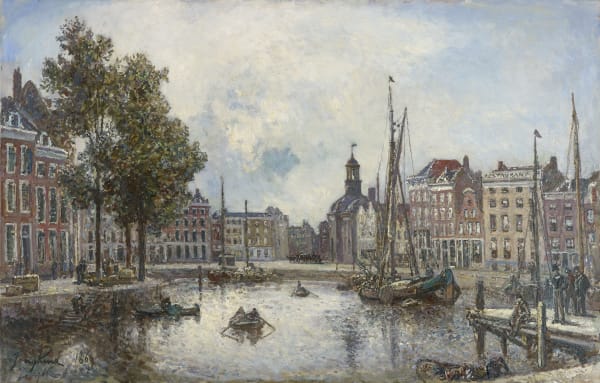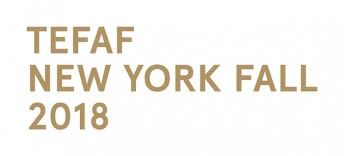Jean-Baptiste Camille Corot French, 1796-1875
Jean-Baptiste-Camille Corot was a prominent French painter, whose work was initially characterised by the historical genre, though evolved to depict naturalistic scenes.
Most notably, Corot has been accredited with establishing the landscape genre as an independent category of nineteenth-century painting. His early sketches, along with his method of painting en plein-air, influenced numerous contemporaries, such as the Barbizon painters. Importantly, Corot’s innovations in painting also opened up a necessary path for later Impressionist painters to embark upon, with their own fresh ideas.
Born in Paris, July 1796, to a middle-class household, Corot devoted himself to painting by the age of twenty-six, with the financial support of his parents.
Initially taught by the landscapist Achille Etna Michallon, after his death, Corot studied under Jean-Victor Bertin. From these lessons, the young artist learned to paint nature directly, scrupulously capturing nature in its liveliness and variance. This attention to detail would characterise his painterly style and, later, he was to state, “Nothing should be left imprecise”. The instruction he received from both teachers, combined historical Neoclassic compositions with Corot’s curiosity for Northern European currents. The amalgamation of these interests paved the way for Corot’s artistic development, as witnessed in the evolution of his landscapes.
From 1825 to 1828, Corot made his first trip to Italy. This journey, along with the other two in 1834 and 1843, were essential in cultivating the artist’s idiosyncratic preferences and subsequent style, where he was able to paint more personal and private works than the public ‘salon’ paintings. Here, Corot was to immerse himself in the pleasure of painting nature, inadvertently neglecting the didactic framework his later ‘salon’ paintings adhered to. As a constant, his interest in plein-air painting developed in concord with his studies of panoramic views, which were artistically expressed with new colours and more fluid brushwork. This period remained crucial as consolidating his artistic identity as a landscape painter.
By 1840, the artist’s reputation was established and the French government had acquired one of his works, which were regularly exhibited at the Salon and often praised by critics.
Travelling extensively to Ville d’Avray (his family home) and other regions in France, such as Burgundy or Provence, the artist would alternate between open-air sketches, studies, and studio work, where he would take on more important compositions and portraits.
From the 1850s, Corot’s style progressed towards a more melancholic, nostalgic approach to nature, favouring the rural countryside idyll as a means to express the lyrical attributes of environment. This is exemplified by the silvery, light essence of his compositions, which seem to be grounded in the artist’s memories. Corot was also intrigued by romantic and mythological portraits, such as those reminiscent of Renaissance painters, namely, Raphael.
Corot remains a pivotal figure, having inspired generations of artists, and his artworks are included in numerous global collections, such as, the National Gallery, London; the Louvre, Paris; Metropolitan Art Museum, New York.
-

TEFAF Maastricht
13 - 20 Mar 2025We are delighted to participate in TEFAF Maastricht 2025, where we are exhibiting a selection of 19th—and 20th-century French paintings and works on paper. Among the highlights is a curated...Read more -

TEFAF Maastricht 2019
16 - 24 Mar 2019For TEFAF Maastricht 2019, Stoppenbach & Delestre is pleased to present a selection of 19th & 20th-century French artworks such as works by Louis Valtat, Henry Moret, Gustave Loiseau, Armand...Read more -

TEFAF New York Fall 2018 - Booth 321
25 - 31 Oct 2018Stoppenbach & Delestre is pleased to announce its participation in TEFAF New York Fall 2018. Featuring works by André Derain, Charles-François Daubigny, Maximilien Luce, Jean-Baptiste Camille Corot, Armand Guillaumin and...Read more




